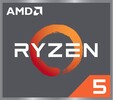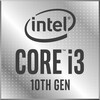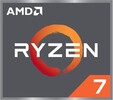AMD Ryzen 5 3500U vs Intel Core i3-10110U vs AMD Ryzen 7 3700U
AMD Ryzen 5 3500U
► remove from comparison
The AMD Ryzen 5 3500U is a mobile SoC that was announced in January 2019. It combines four Zen+ cores (8 threads) clocked at 2.1 GHz to 3.7 GHz with a Radeon RX Vega 8 iGPU with 8 CUs (512 Shaders) clocked at up to 1200 MHz. Specified at 15 Watt TDP, the SoC is intended for thin mid-range laptops. In Chromebooks, AMD calles the APU AMD Ryzen 5 3500C, but the specifications (and performance) are the same.
The Picasso SoC uses the Zen+ microarchitecture with slight improvements that should lead to a 3% IPS (performance per clock) improvements. Furthermore, the 12 nm process allows for higher clocks at similar power consumption.
The integrated dual-channel memory controller supports up to DDR4-2400 memory. As the features of the Picasso APUs are the same compared to the Raven Ridge predecessors, we point to our Raven Ridge launch article.
Performance
The average 3500U in our database matches the Intel Core i7-1065G7 in multi-thread performance to be an OK lower mid-range option, as of early 2021.
The Honor MagicBook 14 is among the fastest laptops powered by the 3500U that we know of. It can be up to 50% faster in CPU-bound workloads than the slowest system featuring the same chip in our database, as of August 2023.
Power consumption
This Ryzen 5 series chip has a default TDP (also known as the long-term power limit) of 15 W, a value that laptop makers are free to set to anything between 12 W and 35 W with clock speeds and performance changing accordingly as a result. Either way, this is a tad too high to allow for passively cooled designs.
The chip is manufactured on a 12 nm process for subpar, as of late 2022, energy efficiency.
Intel Core i3-10110U
► remove from comparison
The Intel Core i3-10110U is a dual-core SoC of the Comet Lake family. The i3 is designed for use in ultraportable laptops of the more affordable flavor as well as mini-PCs. It was announced in August 2019. Just like the other Comet Lake processors, this Core i3 features several advantages over the outgoing Whiskey Lake family including support for faster memory (up to LPDDR4-2933).
Core i3-10110U runs at 2.1 GHz to 4.1 GHz (only 3.7 GHz are reachable when under multi-thread load). Hyper-Threading support is enabled for 4 processing threads in total.
Performance
The average 10110U in our database shapes up to be a decent entry-level CPU, as of late 2021, its multi-thread benchmark scores nearly matching those of the AMD Ryzen 3 3250U and also the Core i3-8145U. While not a whole lot faster than Intel's more affordable Pentium Gold and Pentium Silver chips, the i3 will still let you run most apps with virtually no annoying slowdowns.
Your mileage may vary depending on how high the CPU power limits are and how competent the cooling solution of your system is.
Graphics
The Intel UHD Graphics 620 runs at up to 1,000 MHz. What makes this specific iGPU peculiar is that it only has 23 Execution Units at its disposal, not the 24 EUs typical for a UHD Graphics 620. Otherwise, it's the usual affair with 4K monitor support (up to three displays at the same time) and a hardware video decoder that's friends with VP9, AVC, HEVC but not the newer AV1 video codec.
Power consumption
This Core i3 series chip has a default TDP (also known as the long-term power limit) of 15 W, a value that laptop makers are allowed to change to anything between 10 W and 25 W with clock speeds and performance changing correspondingly. By going for the lowest value, it will be possible to build a passively cooled system around the SoC.
The i3-10110U is built with one of the old 14 nm Intel processees for low, as of early 2023, energy efficiency.
AMD Ryzen 7 3700U
► remove from comparison
The AMD Ryzen 7 3700U is a mobile SoC that was announced in January 2019. It combines four Zen+ cores (8 threads) clocked at 2.3 GHz to 4 GHz with a Radeon RX Vega 10 graphics adapter with 10 CUs (640 shaders) clocked at up to 1,400 MHz. Specified at 15 Watt TDP, the SoC is intended for thin mid-range laptops. In Chromebooks, AMD calles the APU AMD Ryzen 7 3700C, but with the exact same specifications (and performance).
The Picasso SoCs use the Zen+ microarchitecture with slight improvements that should lead to a 3% IPC (performance per clock) improvements.
The integrated dual-channel memory controller supports up to DDR4-2400 memory. As the features of the Picasso APUs are the same compared to the Raven Ridge predecessors, we point to our Raven Ridge launch article.
Performance
The average 3700U in our database is a solid mid-range CPU as of early 2021, its multi-thread benchmark scores matching those of the Core i5-10310U and the Core i5-1035G7 (the Ryzen 5 PRO 3500U is found close nearby as well). This Ryzen 7 is good for more than just binge-watching Netflix and writing e-mails. Just do not expect it to be as fast as a Core i7-11800H.
Thanks to its decent cooling solution and sufficiently high CPU power limits, the ThinkPad E595 is among the fastest laptops powered by the 3700U that we know of. It can be up to 50% faster in CPU-bound workloads than the slowest system featuring the same chip in our database, as of August 2023.
Power consumption
This Ryzen 7 series chip has a default TDP of 15 W (also known as the long-term power limit). This can be changed by a laptop manufacturer to anything between 12 W and 35 W with clock speeds and performance changing accordingly as a result. Either way, that's a little too high to allow for passively cooled designs.
Last but not the least, the Ryzen 7 3700U is manufactured on a 12 nm process for lower-than-average, as of mid-2023, energy efficiency.
| Model | AMD Ryzen 5 3500U | Intel Core i3-10110U | AMD Ryzen 7 3700U | ||||||||||||||||||||||||||||||||||||||||||||||||||||||||||||||||||||||||||||||||||||||||
| Codename | Picasso-U (Zen+) | Comet Lake-U | Picasso-U (Zen+) | ||||||||||||||||||||||||||||||||||||||||||||||||||||||||||||||||||||||||||||||||||||||||
| Series | AMD Picasso (Ryzen 3000 APU) | Intel Comet Lake | AMD Picasso (Ryzen 3000 APU) | ||||||||||||||||||||||||||||||||||||||||||||||||||||||||||||||||||||||||||||||||||||||||
| Series: Picasso (Ryzen 3000 APU) Picasso-U (Zen+) |
|
|
| ||||||||||||||||||||||||||||||||||||||||||||||||||||||||||||||||||||||||||||||||||||||||
| Clock | 2100 - 3700 MHz | 2100 - 4100 MHz | 2300 - 4000 MHz | ||||||||||||||||||||||||||||||||||||||||||||||||||||||||||||||||||||||||||||||||||||||||
| L1 Cache | 384 KB | 256 KB | 384 KB | ||||||||||||||||||||||||||||||||||||||||||||||||||||||||||||||||||||||||||||||||||||||||
| L2 Cache | 2 MB | 1 MB | 2 MB | ||||||||||||||||||||||||||||||||||||||||||||||||||||||||||||||||||||||||||||||||||||||||
| L3 Cache | 4 MB | 4 MB | 4 MB | ||||||||||||||||||||||||||||||||||||||||||||||||||||||||||||||||||||||||||||||||||||||||
| Cores / Threads | 4 / 8 | 2 / 4 | 4 / 8 | ||||||||||||||||||||||||||||||||||||||||||||||||||||||||||||||||||||||||||||||||||||||||
| TDP | 15 Watt | 15 Watt | 15 Watt | ||||||||||||||||||||||||||||||||||||||||||||||||||||||||||||||||||||||||||||||||||||||||
| Transistors | 4500 Million | 4500 Million | |||||||||||||||||||||||||||||||||||||||||||||||||||||||||||||||||||||||||||||||||||||||||
| Technology | 12 nm | 14 nm | 12 nm | ||||||||||||||||||||||||||||||||||||||||||||||||||||||||||||||||||||||||||||||||||||||||
| max. Temp. | 105 °C | 100 °C | 105 °C | ||||||||||||||||||||||||||||||||||||||||||||||||||||||||||||||||||||||||||||||||||||||||
| Socket | FP5 | BGA1528 | FP5 | ||||||||||||||||||||||||||||||||||||||||||||||||||||||||||||||||||||||||||||||||||||||||
| Features | DDR4-2400 RAM, PCIe 3, MMX, SSE, SSE2, SSE3, SSSE3, SSE4A, SSE4.1, SSE4.2, AVX, AVX2, BMI2, ABM, FMA, ADX, SMEP, SMAP, SMT, CPB, AES-NI, RDRAND, RDSEED, SHA, SME | LPDDR3-2133/DDR4-2666/LPDDR4-2933 RAM, PCIe 3, 4 GT/s bus, MMX, SSE, SSE2, SSE3, SSSE3, SSE4.1, SSE4.2, AVX, AVX2, BMI2, ABM, FMA, ADX, VMX, SMEP, SMAP, MPX, EIST, TM1, TM2, Hyper-Threading, Turbo, SST, AES-NI, RDRAND, RDSEED, SGX | DDR4-2400, PCIe 3, MMX, SSE, SSE2, SSE3, SSSE3, SSE4A, SSE4.1, SSE4.2, AVX, AVX2, BMI2, ABM, FMA, ADX, SMEP, SMAP, SMT, CPB, AES-NI, RDRAND, RDSEED, SHA, SME | ||||||||||||||||||||||||||||||||||||||||||||||||||||||||||||||||||||||||||||||||||||||||
| iGPU | AMD Radeon RX Vega 8 (Ryzen 2000/3000) ( - 1200 MHz) | Intel UHD Graphics 620 (300 - 1000 MHz) | AMD Radeon RX Vega 10 ( - 1400 MHz) | ||||||||||||||||||||||||||||||||||||||||||||||||||||||||||||||||||||||||||||||||||||||||
| Architecture | x86 | x86 | x86 | ||||||||||||||||||||||||||||||||||||||||||||||||||||||||||||||||||||||||||||||||||||||||
| Announced | |||||||||||||||||||||||||||||||||||||||||||||||||||||||||||||||||||||||||||||||||||||||||||
| Manufacturer | www.amd.com | ark.intel.com | www.amd.com |
Benchmarks
Average Benchmarks AMD Ryzen 5 3500U → 100% n=47
Average Benchmarks Intel Core i3-10110U → 88% n=47
Average Benchmarks AMD Ryzen 7 3700U → 91% n=47
* Smaller numbers mean a higher performance
1 This benchmark is not used for the average calculation













